 |
Bartholomew "Bat" Masterson1853-1921 |
|
|
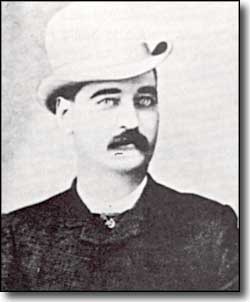
Bartholomew Masterson was the second of seven children born to Catherine and Thomas Masterson. He was born in Henryville, Quebec, and raised on a succession of farms in Canada and the northern United States until in 1870, his family finally settled on a homestead near Wichita, Kansas. After a few months helping the family get settled in, Bat and his older brother Ed headed for the western frontier. The brothers spent several months employed as hide skinners for buffalo hunters. In one of the buffalo camps Bat met Wyatt Earp, who started teaching him how to gamble while drinking. In mid-1872, the brothers contracted a grading job for the Atchison, Topeka and Santa Fe Railroad. This took them into Dodge City just as the town was getting off the ground. As soon as they arrived in town, the contractor they were subcontracting from skipped out with their $300. They went back to the buffalo camps to recoup their losses but next April, when that same contractor descended from the train in Dodge City one day, Bat put a gun to his head and demanded his $300. As soon as the money was handed over, Bat treated all the onlookers to a drink in a nearby saloon. Then he went back to buffalo hunting. Already a superb rifle shot, on July 27, 1874, 21-year-old Bat was the youngest of 29 defenders at the Battle of Adobe Walls in the Texas Panhandle. A picket blacksmith shop, 2 sod stores and a sod saloon had been built to serve regular parties of buffalo hunters at Adobe Walls. With all these white buffalo hunters threatening their way of life, a force of about 700 Arapaho, Kiowa, Comanche, and Cheyenne warriors made a plan to sweep through the Panhandle, killing all the whites. The first engagement was a dawn attack on Adobe Walls. There were 28 men and 1 woman inside, all excellent shots with the famous “Big Fifty” Sharps buffalo gun. Forted up behind the thick adobe walls, they repulsed charge after charge of the Indians. The buffalo hunters were such good shots that one warrior was knocked off his horse almost a mile away. The Indians lost a lot of warriors before they retreated, the whites lost 4 men, including 2 who had been sleeping in a wagon outside the buildings. This fight triggered the Red River War of 1874-1875. Bat worked through this war first as a scout for Colonel Nelson A. Miles, and then as a teamster running mule teams and wagons out of Camp Supply. When the Indians were fianlly beaten and forced onto reservations, the town of Sweetwater, Texas came into being to serve the soldiers and the buffalo hunters who were returning to the area. It was in Sweetwater that Bat Masterson killed the only man he ever killed in a gunfight. And, of course, it was over a saloon girl. A Corporal Melvin A. King barged into the Lady Gay Saloon in Sweetwater on January 24, 1876, and found Bat Masterson and Molly Brennan together. In a jealous rage, he opened fire. The story goes that Molly jumped in front of Bat to protect him but the bullet was a through-and-through and both were wounded anyway. As Bat fell to the floor he shot Corporal King, who had paused to cock his pistol. Both King and Molly died of their wounds, and Masterson began using his famous cane during the course of his long recovery. |
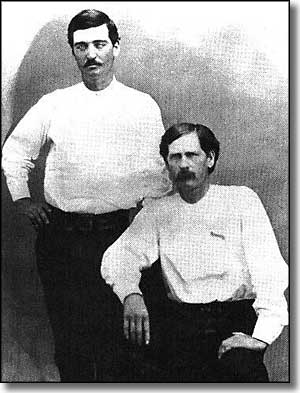 Bat Masterson and Wyatt Earp, Dodge City days In 1877, Masterson returned to Dodge City and purchased an interest in the Lone Star Dance Hall. Shortly thereafter, he had a run-in with the City Marshall over the treatment of a man who was being arrested. Masterson was jailed and fined, although the City Council later refunded his fine. The results of this run-in with the City Marshall caused him to seek an appointment as a Ford County sheriff's deputy (alongside Wyatt Earp). Once in this job, he had the City Marshall fired (Bat's brother Ed then took over as City Marshall). That fall, he and the former City Marshall ran against each other for the county sheriff's job and Bat won, 166-163. He immediately appointed Charlie Bassett as his undersheriff. As Ford County Sheriff, Masterson's jurisdiction ranged 75 miles north to south and 100 miles east to west. Two weeks after taking office, he led a posse in pursuit of six train robbers who'd botched at robbery at Kinsley, Kansas. Outmaneuvering the bandits and two other posses, he set a trap and captured two of the bandits right away. Not long after, he captured three of the remaining four bandits (one of which was Dave Rudabaugh who later rode with Billy the Kid) and that jump-started his reputation as an able lawman. Bat's brother Ed (as City Marshall of Dodge City) had a different approach to enforcing the law. Bat was known as a top-notch gunslinger who practiced constantly. His opponents knew this and wouldn't get into any kind of shooting situation with him. In contrast, Ed was real easy going and hardly ever pulled his gun. As Dodge City grew and attracted more and more rowdy soldiers, con men and petty thieves, Ed found it harder and harder to do his job in his accustomed way. Finally, on April 9, 1878, Ed was fatally wounded in a gunfight with two drunken cowboys outside a saloon. Grief-stricken, Bat led the funeral to the military cemetery at Fort Dodge and buried his brother. Then he went back to leading posses and capturing jail escapees, train robbers, con men, and horse thieves in his inimitable way. |
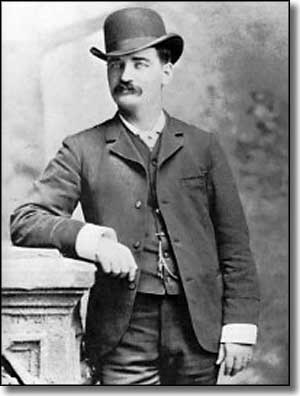 Bat Masterson in 1879 In January, 1879, Bat accepted an appointment as a deputy US Marshall. The following March, he hired on with the Atchison, Topeka and Santa Fe Railroad. He led a posse of gunmen to back up the railroad in its dispute with the Denver & Rio Grande over the right of way through Raton Pass in southern Colorado. The next November he ran for re-election in Ford County, Kansas and lost decisively. In January, 1880, he left the sheriff's office in Dodge City and made his living at cards and faro for a while in places like Trinidad and Leadville. Early in 1881 he spent some time with the Earp brothers in Tombstone, Arizona Territory. Although his main activity in Tombstone was drinking, card playing and dealing faro, he did help Wyatt Earp with business at times. Then his younger brother Jim got into trouble in Dodge City and cried for help. Bat arrived in Dodge City at 11:50 am on April 16, 1881. Stepping off the train, he spotted the two men who were bothering his brother and started yelling at them. Within minutes, there were five people shooting at each other. When they paused to reload, the mayor and the new Sheriff of Dodge City appeared brandishing shotguns and put an end to the action. One of the troublemakers was wounded and they took him to the doctor's office. Bat paid a small fine for his participation in the shoot-out and then boarded the evening train out of town headed west. He was 27 years old and had just had his last gunfight. He wandered around the West for several years, gambling and working as a lawman in different places. In 1882, the City of Trinidad hired Bat to come in and clean up the town. He came with his own deputies in tow. While he was quite the drinker (Masterson was famous for staggering down Main Street late at night and shooting out business lights as he went, then returning in the morning to pay for his damages), his reputation with a gun was such that he was never forced to draw one while he was in Trinidad. His chief deputy however, was tried and convicted of killing a man in a drunken shoot-out about 9 months after he took the job. In spite of their own weaknesses (or, perhaps, because of them), Masterson's team succeeded in cleaning up what was previously one of the roughest towns in the old west. When they left Trinidad in 1883, that marked the end of the town's outlaw era and the beginning of the time when coal was king. The famous shoot-out at the OK Corral in Tombstone, Arizona took place during this time. In the aftermath of that event, the Earp brothers and Doc Holliday left Arizona and came to Trinidad, seeking Bat's help. As the Earp's were erstwhile law enforcement officers, Doc Holliday was not and the state of Arizona wanted to extradite him to Tombstone where he would be tried for murder. In Trinidad, they cooked up a scheme whereby a local judge arraigned Holliday on a series of minor but trumped up charges and then released him on bond. That way, as long as the charges never came to trial (and the judge had no intentions of ever...) and Doc didn't leave the state, the Arizona problem was legally held at bay (Doc Holliday died a free man in his bed at a sanitarium in Glenwood Springs five years later - the local saloon owners were so sad to see their biggest gambling draw leave this Earth that they took up a collection and paid for his funeral). |
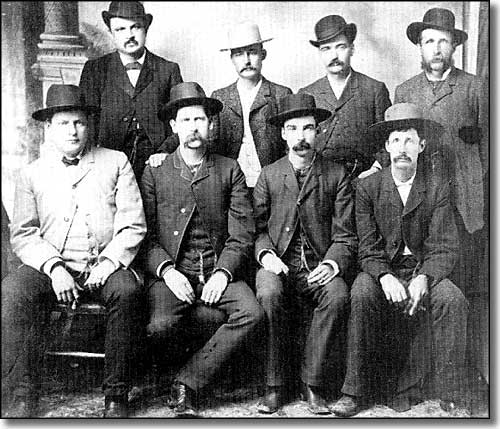 The Famous 1883 Dodge City Peace Commission photo. From left to right, Standing: W.H. Harris, Luke Short, Bat Masterson, W.F. Petillon. Seated: Charlie Bassett, Wyatt Earp, Frank McLain and Neal Brown. |
|
Masterson was in Dodge City in 1883 for the "Dodge City War," a bloodless conflict and gunfighter gathering (this was primarily an argument between saloon owners and the city fathers that went nowhere). There's a story from 1886 wherein Bat pulled his pistol and struck the husband of Nellie Spencer with it. Bat and Nellie ended up running off together but that didn't last long. In 1889 he was living in Denver and got involved in the infamous election ballot stuffing scandal with famous con-man Soapy Smith. After that he bought the Palace Variety Theater and then married the beautiful actress Emma Walters on November 21, 1891. In 1892 he worked for a while as a peace officer and ran the Denver Exchange Club, a gambling house in Creede, but he never got into any shooting matches. Fist fights were one thing but his reputation with a gun still kept everyone else's guns holstered. |
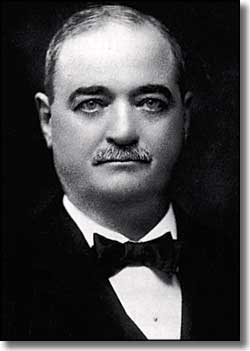
During these years, Bat became more and more active as a sportsman. He especially liked horse races and prize fights. During this time he began writing a weekly sports column for George's Weekly, a Denver newspaper, and he opened the Olympic Athletic Club to promote the sport of boxing. He actively followed and attended boxing matches and was very good at picking the winners. Though he himself never fought in the ring, he often acted as a timekeeper, promoter, referee and second. In 1896, the world heavyweight championship fight between Peter Maher and challenger Bob Fitzsimmons was to be held in El Paso, Texas. Texas state law prohibited prize fights so the governor sent in the Texas Rangers to uphold the law. As the citizens of El Paso had themselves raised the prize money for this fight, the governor's action was very unpopular. Under heavy pressure, fight promoter Dan Stuart made arrangements with Judge Roy Bean and the scene of the fight was moved to Langtry, Texas (where Judge Bean was totally in charge). A ring was built in Mexican territory, just a few hundred yards from Langtry's courthouse and Fitzsimmons took less than two minutes to knock Maher out. One of Bat's functions in all this was to accompany Tom O'Rourke and the $10,000 purse to Langtry and make sure the winner got his winnings. Once this was done, Masterson reboarded the train and returned to Denver where he wrote about the fight in his weekly column. Sometime after this, a club owner named Otto Floto started a vendetta against Bat for some unknown reason. Finally, they duked it out in the street one day and ended with Bat clearly the winner. The pretentiousness of Denver city life must have been hard for him because he turned to the bottle more and more. By 1902, he was so frequently publicly drunk and disorderly that he was formally asked to leave the city. He moved to New York and his life improved immediately. In New York, he was a celebrity and not some troublesome old frontier relic. At one point, Teddy Roosevelt entertained him in the White House and offered him an appointment as U. S. Marshall for Oklahoma. When Bat declined the offer to return to western law enforcement, Roosevelt appointed him deputy U. S. Marshall in New York (at $2,000 per year). Roosevelt left office in 1908 and the next President, Taft, fired Masterson in 1909. About this same time, a Frank Ufer accused Bat of gaining his reputation by shooting Mexicans and Indians in the back. It took two years for the slander case to come to trial but in the end, the court awarded Bat $3,000 in damages after various scouts, gunfighters, sheriffs, and soldiers testified to his skill and his bravery. After that, Bat dabbled in politics for a few years and became a closer friend of Teddy Roosevelt. At one point, he and promoter Tex Rickard sat with Roosevelt and they all discussed military strategy for the upcoming fighting in World War I. On January 6, 1919, Teddy Roosevelt died from a fever he had contracted in a South American jungle. Bat was quite broken up over this but in memory of his good friend, he spent his last years writing his columns, visiting gyms and promoting the sport of boxing. On the morning of October 25, 1921, he arrived at his desk to catch up on paperwork and write his regular column. As he worked on his column, he slumped over his typewriter and died of a heart attack. His last typewritten words: "There are those who argue that everything breaks even in this old dump of a world of ours. I suppose these ginks who argue that way hold that because the rich man gets ice in the summer and the poor man gets it in the winter things are breaking even for both. Maybe so, but I'll swear I can't see it that way." The authoritative Encyclopedia of Western Gunfighters (Bill O'Neal, University of Oklahoma Press, 1979), lists Bat Masterson with one gunfight killing in three fights. When compared to many other well known gunmen of the Old West, including Dallas Stoudenmire, "Wild Bill" Hickok, and Clay Allison, Masterson has a less than impressive record. He was well-known as a gunman, probably because of his shameless self-promotion (through most of his adult life Bat Masterson referred to himself as "the Genius"). Not counting any men he might have killed at the Battle of Adobe Walls or on the frontier, he is confirmed to have killed only one man in a gunfight. His brother James was involved in three more gunfights than Bat, but he earned no notoriety from any of them. As a Dodge City lawman, his brother Ed was in two shootouts and killed both assailants, although he himself was wounded in the first shootout and killed in the second. Therefore, it was most likely Bat Masterson's ability to promote himself, more than any actual accomplishments, that led to his fame. He also, apparently, had some facility with the ladies. And then there's that TV show... |
|
|
 |
| Index - Arizona - Colorado - Idaho - Montana - Nevada - New Mexico - Utah - Wyoming National Forests - National Parks - Scenic Byways - Ski & Snowboard Areas - BLM Sites Wilderness Areas - National Wildlife Refuges - National Trails - Rural Life Sponsor Sangres.com - About Sangres.com - Privacy Policy - Accessibility |
| The black and white photos on this page are in the public domain. Text Copyright © by Sangres.com. All rights reserved. |